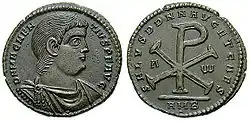Battle of Mons Seleucus
The Battle of Mons Seleucus was fought in 353 between the forces of the Roman emperor Constantius II and the forces of the usurper Magnentius.[lower-alpha 1][lower-alpha 2] Constantius' forces were victorious, and Magnentius later committed suicide.
| Battle of Mons Seleucus | |||||||
|---|---|---|---|---|---|---|---|
| Part of the Roman civil war of 350–353 | |||||||
 Magnentius. 350-353 AD. Æ Double Centenionalis (8.88 gm). Amiens mint. | |||||||
| |||||||
| Belligerents | |||||||
| Roman Empire | Roman Empire | ||||||
| Commanders and leaders | |||||||
| Constantius II | Magnentius | ||||||
Background
Following his defeat at Mursa, Magnentius fled to Aquileia. This campaign included summoning all those loyal to him to support him in Aquileia. Decentius, brother of Magnentius and newly made Caesar,[3] was engaged with an incursion of Alemanni, and was unable to lend his army to support Magnentius.[4]
Constantius spent his time recruiting troops and retaking towns occupied by Magnentius. In the summer of 352, Constantius moved into Italy, only to find that Magnentius had chosen not to defend the peninsula.[1]
Battle
The armies met at Mons Seleucus, in what is now La Bâtie-Montsaléon in Hautes-Alpes, south-eastern France.[5] Constantius was again victorious and Magnentius took his own life on 10 August 353.[5]}}[lower-alpha 3] Following his conclusive battle, Constantius wintered his troops at Arles.[7]
Aftermath
Constantius, now undisputed Emperor of the Roman Empire, appointed Julian Caesar over the western half of the Empire in 355/6,[8] and instigated a campaign to persecute those that had supported Magnentius. According to Ammianus Marcellinus, Constantius' notarii and his bodyguards needed only mere suspicion to inflict punishment and that Constantius became more "cruel, violent, and suspicious with age".
Notes
- Crawford states there is little reliable information concerning the exact date of the battle of Mons Seleucus from surviving sources.[1]
- Eutropius states that the usurper was "defeated in several battles", possibly leading up to the final battle at Mons Seleucus.[2]
- Frakes states Magnentius and Decentius were executed by Constantius[6]
References
- Crawford 2016, p. 81.
- Crawford 2016, p. 82, 292.
- Hunt 1998, p. 17.
- Crawford 2016, p. 80.
- Crawford 2016, p. 82.
- Frakes 2006, p. 101.
- Hunt 1998, p. 22.
- Barnes 1993, p. 20.
Sources
- Barnes, Timothy David (1993). Athanasius and Constantius: Theology and Politics in the Constantinian Empire. Harvard University Press. ISBN 0-674-05067-3.
- Crawford, Peter (2016). Constantius II: Usurpers, Eunuchs, and the Antichrist. Pen & Sword. ISBN 978 1 78340 055 3.
- Frakes, Robert M. (2006). "The Dynasty of Constantine down to 363". In Lenski, Noel Emmanuel (ed.). The Cambridge Companion to the Age of Constantine, Volume 13. Cambridge University Press.
- Hunt, David (1998). "The successors of Constantine". In Cameron, Averil; Garnsey, Peter (eds.). The Cambridge Ancient History: The late empire, A.D. 337-425. XIII (2nd ed.). Cambridge University Press. p. 1-43.